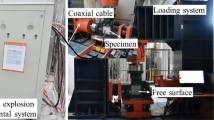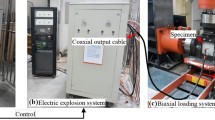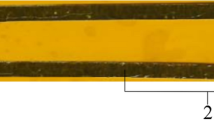Abstract
Crater blasting is widely used for rock excavation. In deep rock engineering projects, blasting is done in a high stress environment. To study the effects of high geological stresses on rock blasting, crater blasting tests on sandstone using an exploding electric wire were conducted under three different static load conditions. The evolution of the strain fields and the propagation of cracks on the surfaces of samples were recorded and subsequently analysed by digital image correlation. The rock fracturing mechanisms are discussed. The experimental results indicate that (1) the areas of major principal strain on the sample surfaces are circular under conditions of no static stress and symmetric biaxial stress loads, but the strain area is elliptical under a uniaxial load; (2) after blasting, the static stress state changes the crack initiation mode, crack propagation, and the distribution of the cracks in the crack network; and (3) static stress can increase the size of the blasting crater.












Similar content being viewed by others
References
Cai MF, Peng H, Ji HG (2008) New development of hydraulic fracturing technique for in-situ stress measurement at great depth of mines. J Univ Sci Technol Beijing Miner Metall Mater 15(6):665–670
Chen JJ, Guo BQ, Liu HB, Liu H, Chen PW (2014) Dynamic Brazilian test of brittle materials using the split Hopkinson pressure bar and digital image correlation. Strain 50(6):563–570
Donze FV, Bouchez J, Mangnier SA (1997) Modeling fractures in rock blasting. Int J Rock Mech Min Sci 34(8):1153–1163
Egger P (2000) Design and construction aspect of deep tunnels (with particular emphasis on strain softening rocks). Tunn Undergr Space Technol 15(4):403–408
Fourney WL, Dick RD, Wang XJ, Wei Y (1993) Fragmentation mechanism in crater blasting. Int J Rock Mech Min Sci 30(4):413–429
Kang HP, Zhang X, Si LP, Wu Y, Gao FQ (2010) In-situ stress measurements and stress distribution characteristics in underground coal mines in China. Eng Geol 116(3):333–345
Kutter HK, Fairhurst C (1971) On the fracture process in blasting. Int J Rock Mech Min Sci 8(3):181–202
Liu JP, Li YH, Xu SD (2018) Relationship between microseismic activities and mining parameters during deep mining process. J Appl Geophys 159:814–823
Ma GW, An XM (2008) Numerical simulation of basting-induced rock fractures. Int J Rock Mech Min Sci 45(6):966–975
McHugh S (1983) Crack extension caused by internal gas pressure compared with extension caused by tensile stress. Int J Fract 21(3):163–176
Peng JY, Zhang FP, Yan GL, Qiu ZG, Dai XH (2019) Experimental study on rock-like materials fragmentation by electric explosion method under high stress condition. Powder Technol 356:750–758
Shan ZG, Yan P (2010) Management of rock bursts during excavation of the deep tunnels in Jinping II Hydropower Station. B Eng Geol Environ 69(3):353–363
Wang ZL, Li YC, Shen RF (2007) Numerical simulation of tensile damage and blast crater in brittle rock due to underground explosion. Int J Rock Mech Min Sci 44(5):730–738
Xiao SY, Su LJ, Jiang YJ, Liu ZX (2019) Numerical analysis of hard rock blasting unloading effects in high in situ stress fields. B Eng Geol Environ 78(2):867–875
Xie LX, Lu WB, Zhang QB, Jiang QH, Wang GH, Zhao J (2016) Damage evolution mechanisms of rock in deep tunnels induced by cut blasting. Tunn Undergr Space Technol 58:257–270
Xie LX, Lu WB, Zhang QB, Jiang QH, Chen M, Zhao J (2017) Analysis of damage mechanisms and optimization of cut blasting design under high in-situ stresses. Tunn Undergr Space Technol 66:19–33
Xing HZ, Zhang QB, Ruan D, Dehkhoda S, Lu GX, Zhao J (2018) Full-field measurement and fracture characterisations of rocks under dynamic loads using high-speed three-dimensional digital image correlation. Int J Impact Eng 113:61–72
Xu NW, Dai F, Li B, Zhu YG, Zhao T, Yang DS (2017) Comprehensive evaluation of excavation-damaged zones in the deep underground caverns of the Houziyan hydropower station, Southwest China. B Eng Geol Environ 76(1):275–293
Yang LY, Ding CX (2018) Fracture mechanism due to blast-imposed loading under high static stress conditions. Int J Rock Mech Min Sci 107:150–158
Yang RS, Ding CX, Yang LY, Chen C (2018a) Model experiment on dynamic behavior of jointed rock mass under blasting at high-stress conditions. Tunn Undergr Space Technol 74:145–152
Yang RS, Ding CX, Yang LY, Lei Z, Zhang ZR, Wang YB (2018b) Visualizing the blast-induced stress wave and blasting gas action effects using digital image correlation. Int J Rock Mech Min Sci 112:47–54
Yang RS, Ding CX, Li YL, Yang LY, Zhao Y (2019) Crack propagation behavior in slit charge blasting under high static stress conditions. Int J Rock Mech Min Sci 119:117–123
Yilmaz O, Unlu T (2013) Three dimensional numerical rock damage analysis under blasting load. Tunn Undergr Space Technol 38:266–278
Zhang FP, Peng JY, Qiu ZG, Chen QK, Li YH, Liu JP (2017) Rock-like brittle material fragmentation under coupled static stress and spherical charge explosion. Eng Geol 220:266–273
Zhou ZL, Tan LH, Cao WZ, Zhou ZY, Cai X (2017) Fracture evolution and failure behaviour of marble specimens containing rectangular cavities under uniaxial loading. Eng Fract Mech 184:183–201
Zhu ZM (2009) Numerical prediction of crater blasting and bench blasting. Int J Rock Mech Min Sci 46:1088–1096
Zhu ZM, Mohanty B, Xie HP (2007) Numerical investigation of blasting-induced crack initiation and propagation in rocks. Int J Rock Mech Min Sci 44(3):412–424
Zhu ZM, Xie HP, Mohanty B (2008) Numerical investigation of blasting-induced damage in cylindrical rocks. Int J Rock Mech Min Sci 45(2):111–121
Zhu ZM, Wang C, Kang JM, Li YX, Wang M (2014) Study on the mechanism of zonal disintegration around an excavation. Int J Rock Mech Min Sci 67:88–95
Funding
This work was supported by the State Key Research Development Program of China (Grant Nos. 2017YFC0602902 and 2016YFC0600706). We thank David Frishman, PhD, from Liwen Bianji, Edanz Editing China (www.liwenbianji.cn/ac), for editing the English text of a draft of this manuscript.
Author information
Authors and Affiliations
Corresponding author
Rights and permissions
About this article
Cite this article
Zhang, F., Yan, G., Peng, J. et al. Experimental study on crack formation in sandstone during crater blasting under high geological stress. Bull Eng Geol Environ 79, 1323–1332 (2020). https://doi.org/10.1007/s10064-019-01665-1
Received:
Accepted:
Published:
Issue Date:
DOI: https://doi.org/10.1007/s10064-019-01665-1




